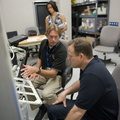
WIKIARCHIVES.SPACE
The Human Spaceflight Archive

One of three large pit craters so far found on the Moon -- do these pits provide access to open lava tubes? Image is 1170 meters wide, or 3838 feet, LROC NAC M106662246R.
Information
- Taken in
- Author
- NASA/GSFC/Arizona State University
- Description
-
One of three large pit craters so far found on the Moon -- do these pits provide access to open lava tubes? Image is 1170 meters wide, or 3838 feet, LROC NAC M106662246R.
The Kaguya team discovered three mare pit craters, all about 100 meters in diameter. Since the Kaguya Terrain Camera had a pixel scale of about 10 meters they could not definitively identify pit craters much smaller than 100 meters. This raises a key question - are there smaller pit craters to be found? The answer is most likely yes. The LROC team is searching images that are already on the ground and is targeting areas around pits for more coverage. To date, we have about ten candidate pits awaiting confirmation.
NASA's Goddard Space Flight Center built and manages the mission for the Exploration Systems Mission Directorate at NASA Headquarters in Washington. The Lunar Reconnaissance Orbiter Camera was designed to acquire data for landing site certification and to conduct polar illumination studies and global mapping. Operated by Arizona State University, LROC consists of a pair of narrow-angle cameras (NAC) and a single wide-angle camera (WAC). The mission is expected to return over 70 terabytes of image data.
- Created on
- Wednesday 14 July 2010
- Albums
- US SPACE PROGRAM / PROBES / MOON / LRO/LCROSS / Mission Photos (Edited)
- Source link
- https://photojournal.jpl.nasa.gov
- Visits
- 16
- Rating score
- no rate
- Rate this photo
- License
- Public Domain
- Modified by WikiArchives
- No (original)
- Downloads
- 0
Powered by Piwigo




























